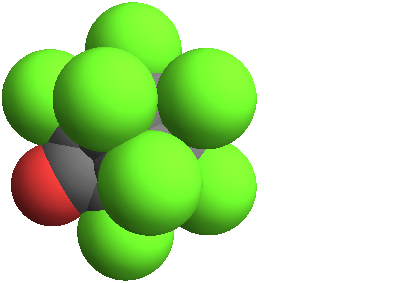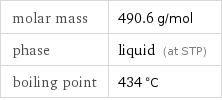Input interpretation

chlordecone
Chemical names and formulas

formula | C_10Cl_10O name | chlordecone alternate names | chlorodecone | clordecone | decachloroketone | kepone mass fractions | C (carbon) 24.5% | Cl (chlorine) 72.3% | O (oxygen) 3.26%
Lewis structure

Draw the Lewis structure of chlordecone. Start by drawing the overall structure of the molecule, ignoring potential double and triple bonds: Count the total valence electrons of the carbon (n_C, val = 4), chlorine (n_Cl, val = 7), and oxygen (n_O, val = 6) atoms: 10 n_C, val + 10 n_Cl, val + n_O, val = 116 Calculate the number of electrons needed to completely fill the valence shells for carbon (n_C, full = 8), chlorine (n_Cl, full = 8), and oxygen (n_O, full = 8): 10 n_C, full + 10 n_Cl, full + n_O, full = 168 Subtracting these two numbers shows that 168 - 116 = 52 bonding electrons are needed. Each bond has two electrons, so in addition to the 25 bonds already present in the diagram add 1 bond. To minimize formal charge oxygen wants 2 bonds and carbon wants 4 bonds. Identify the atoms that want additional bonds and the number of electrons remaining on each atom: Fill in the 1 bond by pairing electrons between adjacent highlighted atoms: Answer: | |
3D structure

3D structure
Basic properties

molar mass | 490.6 g/mol phase | liquid (at STP) boiling point | 434 °C
Units

Liquid properties (at STP)

vapor pressure | 1×10^-7 mmHg (at 25 °C)
Units

Thermodynamic properties

molar heat of vaporization | 69 kJ/mol specific heat of vaporization | 0.141 kJ/g (at STP)
Chemical identifiers

CAS number | 143-50-0 Beilstein number | 1894593 PubChem CID number | 245038 SMILES identifier | C1(=O)C2(C3(C4(C1(C5(C2(C3(C(C45Cl)(Cl)Cl)Cl)Cl)Cl)Cl)Cl)Cl)Cl InChI identifier | InChI=1/C10Cl10O/c11-2-1(21)3(12)6(15)4(2, 13)8(17)5(2, 14)7(3, 16)9(6, 18)10(8, 19)20/t2?, 3?, 4-, 5-, 6?, 7?, 8?, 9?/m0/s1 EU number | 205-601-3 RTECS number | PC8575000 NSC number | 124074
Safety properties

flash point | 183 °C

DOT numbers | 2761
Toxicity properties

RTECS classes | agricultural chemical and pesticide | tumorigen | mutagen | reproductive effector